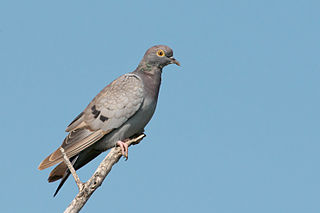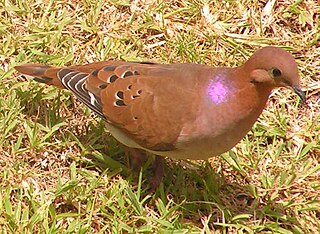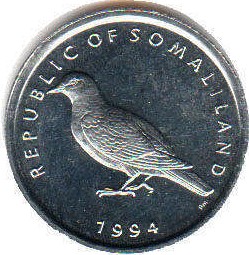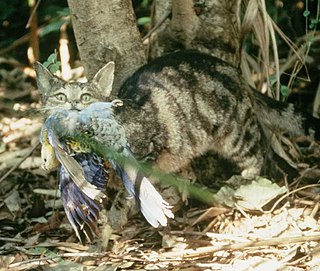
The passenger pigeon or wild pigeon is an extinct species of pigeon that was endemic to North America. Its common name is derived from the French word passager, meaning "passing by", due to the migratory habits of the species. The scientific name also refers to its migratory characteristics. The morphologically similar mourning dove was long thought to be its closest relative, and the two were at times confused, but genetic analysis has shown that the genus Patagioenas is more closely related to it than the Zenaida doves.

Columbidae is a bird family consisting of doves and pigeons. It is the only family in the order Columbiformes. These are stout-bodied birds with short necks and short slender bills that in some species feature fleshy ceres. They primarily feed on plants, and can be taxonomically divided amongst granivores, that feed mostly on the ground on seeds, and frugivores, that feed mostly on fruits, from branches. The family occurs worldwide, often in close proximity with humans, but the greatest variety is in the Indomalayan and Australasian realms.

The rock dove, rock pigeon, or common pigeon is a member of the bird family Columbidae. In common usage, it is often simply referred to as the "pigeon", although this is the wild form of the bird; the pigeons most familiar to people are the domesticated form of the wild rock dove.

The stock dove or stock pigeon is a species of bird in the family Columbidae, the doves and pigeons. It is widely distributed in the western Palearctic.

The common wood pigeon, also known as simply wood pigeon, is a large species in the dove and pigeon family (Columbidae), native to the western Palearctic. It belongs to the genus Columba, which includes closely related species such as the rock dove. It has a flexible diet, predominantly feeding on vegetable matter, including cereal crops, leading to them being regarded as an agricultural pest. Wood pigeons are extensively hunted over large parts of their range, but this does not seem to have a great impact on their population.

The bird genus Columba comprises a group of medium to large pigeons. The terms "dove" and "pigeon" are used indiscriminately for smaller and larger Columbidae, respectively. Columba species – at least those of Columba sensu stricto – are generally termed "pigeons", and in many cases wood-pigeons. The rock dove has given rise to the majority of domesticated pigeon breeds, such as the racing pigeon and the fantail pigeon, some of which have become feral. Meanwhile, "wood pigeon" by itself usually means the common wood pigeon.

The laughing dove is a small pigeon that is a resident breeder in Africa, the Middle East, South Asia, and Western Australia where it has established itself in the wild after being released from Perth Zoo in 1898. This small long-tailed dove is found in dry scrub and semi-desert habitats where pairs can often be seen feeding on the ground. It is closely related to the spotted dove which is distinguished by a white and black chequered necklace. Other names include laughing turtle dove, palm dove and Senegal dove while in Asia the name little brown dove is often used.

The trocaz pigeon, Madeira laurel pigeon or long-toed pigeon is a pigeon which is endemic to the island of Madeira, Portugal. It is a mainly grey bird with a pinkish breast; its silvery neck patch and lack of white wing markings distinguish it from its close relative and probable ancestor, the common wood pigeon. Its call is a characteristic six-note cooing, weaker and lower-pitched than that of the wood pigeon. Despite its bulky, long-tailed appearance, this pigeon has a fast, direct flight.

The pink pigeon is a species of pigeon in the family Columbidae endemic to Mauritius. The pink pigeon nearly became extinct in the 1970s and the 1990s and is still very rare. It is the only Mascarene pigeon that has not become extinct. It was on the brink of extinction in 1991 when only 10 individuals remained, but its numbers have increased due to the efforts of the Durrell Wildlife Conservation Trust since 1977. While the population remains at below 500 birds as of 2011, the IUCN downlisted the species from Critically endangered to Endangered on the IUCN Red List in 2000, and then downlisted it again to Vulnerable in 2018.

A clutch of eggs is the group of eggs produced by birds, amphibians, or reptiles, often at a single time, particularly those laid in a nest.

The domestic pigeon is a pigeon subspecies that was derived from the rock dove or rock pigeon. The rock pigeon is the world's oldest domesticated bird. Mesopotamian cuneiform tablets mention the domestication of pigeons more than 5,000 years ago, as do Egyptian hieroglyphics. Pigeons were most likely domesticated in the Mediterranean at least 3000–5000 years ago, and may have been domesticated earlier as a food source. Research suggests that domestication of pigeons occurred as early as 10,000 years ago.

The yellow-eyed pigeon, pale-backed pigeon, yellow-eyed dove or yellow-eyed stock dove is a member of the family Columbidae. It breeds in southern Kazakhstan, Uzbekistan, Turkmenistan, Tajikistan, Kyrgyzstan, Afghanistan, north-east Iran and extreme north-west China. It winters in north-east Pakistan, Jammu and Kashmir and parts of Rajasthan. The bird has declined in numbers over the years, chiefly because of hunting, and it is listed as "vulnerable" by the International Union for Conservation of Nature.

The white-winged dove is a dove whose native range extends from the Southwestern United States through Mexico, Central America, and the Caribbean. They are large for doves, and can be distinguished from similar doves by the distinctive white edge on their wings. They have a blue eyering, and red eyes. The plumage is brownish-gray to gray. Juveniles are duller in color, and have brown eyes. The call is likened to English phrase "who cooks for you". There are three subspecies. It was first described by George Edwards in 1743, and given its binomial name by Linnaeus in 1756. It was moved into the genus Zenaida in 1838.

The fauna of Barbados comprises all the animal species inhabiting the island of Barbados and its surrounding waters. Barbados has less biodiversity than the other Antilles. Human activities are responsible for the change in the composition of the fauna, in particular, the replacement of native species. Species that are able to adapt to human presence have survived.

The Somali pigeon or Somali stock dove is a species of bird in the family Columbidae. It is endemic to Somalia. Because there has hardly been any research on the species, the health of the population is uncertain; however, it is believed that the species is relatively rare. The IUCN Redlist identified a possible threat to the species from the speckled pigeon. C. oliviae is found mostly on the ground, where it often forages, most frequently in rock along arid coasts.

Urban wildlife is wildlife that can live or thrive in urban/suburban environments or around densely populated human settlements such as townships.
Nicarbazin is a coccidiostat used on meat chickens. It is also used as a contraceptive for population control of Canada geese and feral pigeons.
Population control is the practice of artificially maintaining the size of any population. It simply refers to the act of limiting the size of an animal population so that it remains manageable, as opposed to the act of protecting a species from excessive rates of extinction, which is referred to as conservation biology.

Cat predation on wildlife is the result of the natural instincts and behavior of both feral and owned house cats to hunt small prey, including wildlife. Some people view this as a desirable phenomenon, such as in the case of barn cats and other cats kept for the intended purpose of pest control in rural settings; but scientific evidence does not support the popular use of cats to control urban rat populations, and ecologists oppose their use for this purpose because of the disproportionate harm they do to native wildlife. As an invasive species and predator, they do considerable ecological damage.
Invasive species are species that are native to foreign environments which may have important effects on a specific area's economy, ecosystem and infrastructure. These species can be introduced by natural causes or human intervention. There are many invasive species that exist around the world. One that is abundant around Puerto Rico is the lionfish. The United States Department of Agriculture (USDA)'s Animal and Plant Health Inspection Service (APHIS) Plant Protection and Quarantine (PPQ) and Customs and Border Protection (CBP) perform biosecurity inspections for Puerto Rico.


























